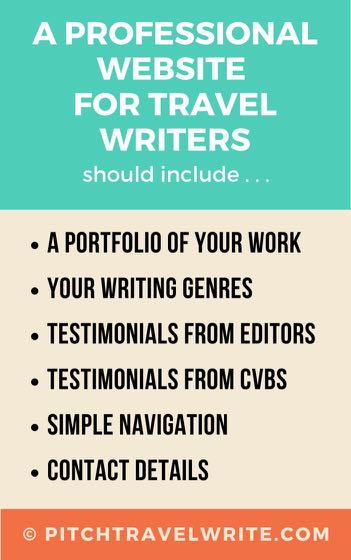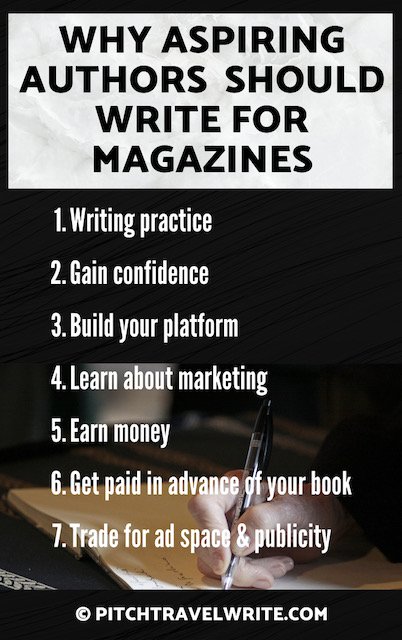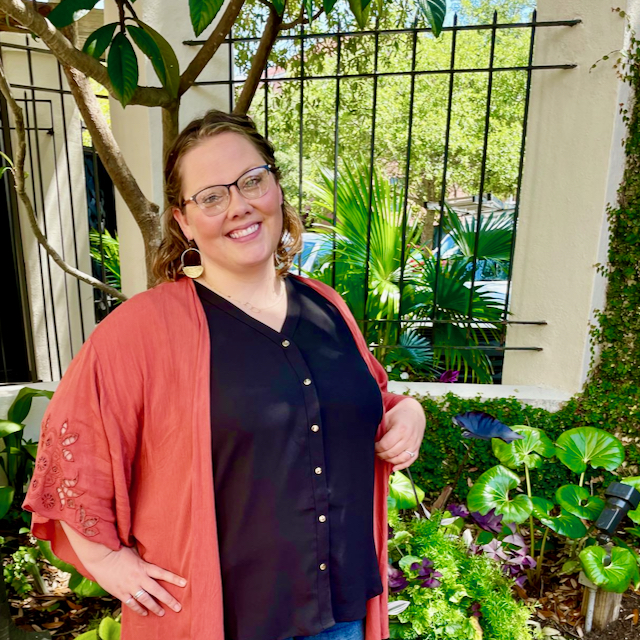- Home
- Business Basics for Travel Writers
- Building Your Writer's Website
Building a Professional Website for Freelance Travel Writers
By Roy Stevenson
Do you have a professional website for your travel writing business?
I’ve met hundreds of freelance travel writers in the past seventeen years and have been surprised at how few have a writer's website. A well laid out website that shows indisputable evidence that you are well published is an essential tool.
Will your writer's website garner you more assignments with magazine editors just by its mere presence? Maybe, maybe not.
But, a professionally designed website will very likely tip the scales in your favor when you’re querying an editor with a story idea. If the editor doesn't know you and is undecided about hiring you, a well-designed website will nudge them in the right direction.
Today, there is little excuse not to have a website and most editors expect it. Your professional website is your writing portfolio and it can serve in so many other ways.
Building a website doesn't have to be expensive or difficult. And it's an important marketing tool for a freelance writer. And having a web presence enhances your credibility. It is effortless promotion that an editor can access 24/7.
What should your professional website include?
I'll use my own writer's website (www.roy-stevenson.com) as an example.
Here’s a screenshot to show you what editors see when they follow the link to my site.
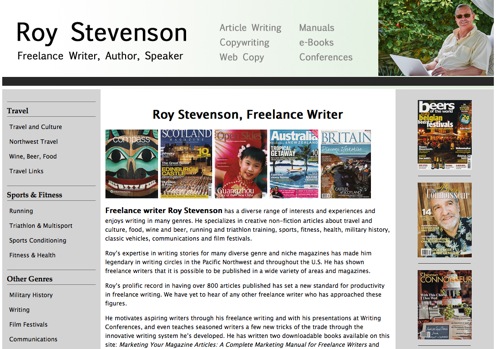 A well-designed website will help editors know more about you, your writing, the genres you write in, and the magazines that have published your work.
A well-designed website will help editors know more about you, your writing, the genres you write in, and the magazines that have published your work.It's important to show you're a published writer. One of the best ways to show this is through two very important sections on your writer’s website:
- one section describes each of your writing genres
- another section has testimonials from editors and tourist agencies
These sections are obvious
necessities for all travel writers. Yet I seldom see other travel
writers using them. So it’s one important way you can differentiate
yourself from all the other travel writers out there.
I parlay my
professional website to magazine editors and tourism agencies to get
their attention for assignments and more travel than I can handle. You can do this with your website, too.
A Professional Website is a Marketing Tool
One thing you want to remember is you're not creating a professional website for friends and family. There are only two kinds of people who you need to impress with your writer’s website:
- magazine editors who can buy your work, and
- tourism agency professionals who can provide you with travel story ideas and assistance with your travel arrangements
Your website isn’t designed to impress your friends or other freelance writers with your writing prowess — they aren’t in a position to buy your articles. (And probably they’re not very interested in your work, anyway.)
So, when I’m planning a trip and pitching stories, my objective is to convince editors that I’m a seasoned travel writer. And I want them to know that I’ve written for a large number of magazines.
My query letters also refer editors to my professional website to see samples of my work. If they are considering one of my pitches, a glance at my writer’s website will help them decide. It will tip the scales in favor of assigning me the story.
You want to design your website to assure travel editors that you are an active, professional travel writer. And if you don't know the editor, you also want to convince them that you are able to deliver your stories on time and that you do high quality work.
Keep the Navigation Simple

Ideally, your professional website will contain several samples of your travel articles. You want to post enough articles to show that you’ve been published consistently over time. Keep your website updated. Add new articles every month or two to show that you are still being published consistently.
If you write in different genres, even within the “travel” category, I’d suggest that you have separate navigation links to each genre. For example, I have separate navigation for “Northwest Travel” which is one of my specialties, and separate navigation for “Wine, Beer, Food” – another specialty.
My other travel articles published in print are in a separate category named “Travel and Culture” and my online articles are shown under “Travel Links”. You'll divide your stories differently than I have, but the point is to segregate your articles in a way that makes sense.
Each category needs to be specific enough that editors interested in a particular specialty area can easily find samples. This is important – editors are busy people and they won’t waste their time on a confusing or complex website.
I know that lots of people are building professional websites with all sorts of bells and whistles these days and they look really trendy. But unless you’re selling web design expertise rather than your writing skills, I’d suggest that you focus on simplicity. Do everything in your power to keep your professional website simple and easy to navigate. Editors and travel agencies will love you for it.
Get Testimonials from Editors
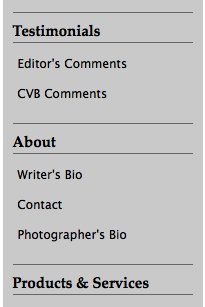
Showing samples within your different writing genres displays your portfolio for editors to scan. Your portfolio is especially important to editors not familiar with your work.
But the ace-in-the-hole for marketing yourself is when you add testimonials.
As you build up your writing portfolio you can be collecting feedback from editors about your work. Sometimes this feedback is given freely; other times you need to ask for it.
In either case, always ask the editor’s permission before posting a testimonial on your website.
The section titled “Editor’s Comments” on my website has over one dozen glowing reports from magazine editors about my work. These testimonials provide evidence of my ability to come up with good story ideas and meet deadlines.
If you go to this section on my website, you’ll notice that the editor’s names and publications are listed with their comments. This way, other editors can contact them to verify the testimonials. It's a small world and many editors know each other.
Once I've lined up several travel assignments, it’s time to contact the tourism agencies at my destination to see how they can help with my travel arrangements.
So the other major purpose of your professional website is to convince tourism agencies (in the U.S. we call them Convention and Visitor’s Bureaus, or CVBs) that you are worth their effort and expense of covering your hotel, meals, and entry to tourist attractions in their city or region.
When I contact CVBs, I’ll refer them to my travel website sections to convince them that I’m a well-published travel writer. They'll be interested in both print and online publications so make sure you refer them to relevant links on your website.
Providing a large number of writing samples shows the tourism agencies that you’re not a ‘pretender’ who is out to take advantage of their assistance.
Unfortunately, some people call themselves travel writers, milk the tourist agency’s assistance and goodwill and then disappear off into the sunset, without ever delivering the promised travel story. As a result, many CVB’s are skeptical about a writers, so this is one more way your website can help you.
Get Testimonials from Tourist Agencies
You want to convince tourism agencies beyond any doubt that you have
produced copious travel articles, and that you’re not one of those
working the system. So, add a section to your professional website with
comments from the CVBs you’ve already worked with successfully.
If you’ve done a good job of writing
one or more articles, they are typically happy to provide a paragraph or
two describing what it was like to work with you. After
I’ve produced articles from a previous press trip, I contact the CVB and
request a testimonial via email.
And, as with
“Editor’s Comments” section, you'll want to list the names of the
tourism agency professionals who provided comments. The tourism
industry, especially within a state or region, is small enough that they
know each other. They often contact their
colleagues to verify a writer’s abilities and productivity and find out what it was like to work with you.
Let Your Website Show Off Your Work
The overall effect your writer’s website should be to show evidence of a
good cross-section of your work, to prove your travel writing
background and provide real-world credentials from the people who have
worked with you – the editors and tourist agencies.
Putting
together a well designed, professional website will
enhance your marketing efforts. You’ll find it will save you time and
give you credibility that simply doesn’t come across in a query
letter alone.
Your professional writer's website will give strong support to your query letter to an editor you don't know - let your website do this work for you.
If you want another way to highlight your portfolio, you should also get some of your work published online. Here are four reasons every writer should do this ...
Do you need help writing query letters that catch the attention of editors?
If you're looking for a guide to help you write query letters to editors, I've written The Complete Guide to Query Letters for Travel Writers to help you. It includes everything you need to know about query letters, along with 20 sample query letters that you can use as templates for your own queries.
More related articles that will interest you:
How to Get Testimonials from Editors and CVB's
Five Travel Writing Secrets for Success - Part 1
Travel Writing Secrets for Success - Part 2
Facebook Tips for Travel Writers

Roy Stevenson is a professional travel writer and the author of www.PitchTravelWrite.com. Over the past ten years, he’s had more than 1000 articles published in 200 magazines, trade and specialty journals, in-flights, on-boards, blogs and websites and has traveled on assignment around the U.S. and to dozens of international destinations.
IF YOU ENJOYED THIS POST, GET UPDATES. IT'S FREE.
